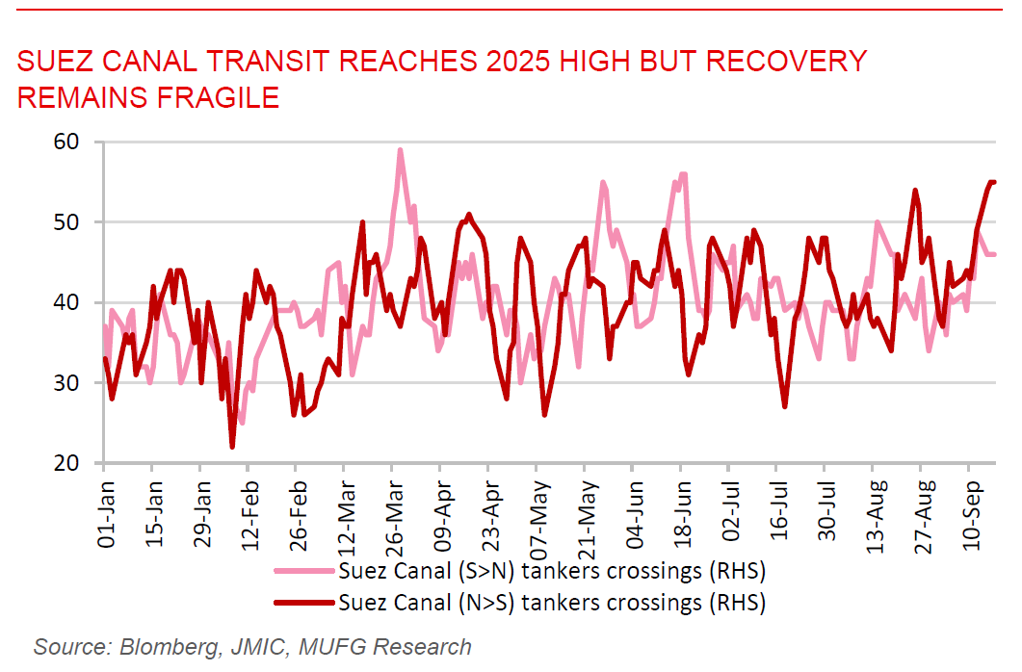To read the full report, please download the PDF above.
Middle East Daily
SOOJIN KIM
Research Analyst
DIFC Branch – Dubai
T: +44(4)387 5031
E: soojin.kim@ae.mufg.jp
MUFG Bank, Ltd. and MUFG Securities plc
A member of MUFG, a global financial group
Middle East Daily
COMMODITIES / ENERGY
Oil steadies after gains amid Ukraine strikes and supply glut concerns. Oil prices held steady after a three-day rally, with Brent above USD68/b and WTI near USD64/b, as markets weighed Ukraine’s strike on Russia’s Saratov refinery. While geopolitical tensions have supported prices, crude remains locked in a narrow USD5 trading band seen over the past month, pressured by bearish fundamentals and expectations of a supply glut from the accelerated return of OPEC+ output. The European Union is considering new sanctions on India and Chinese firms that facilitate Russian oil flows, while also pushing to speed up its phase-out of Russian fossil fuel imports in the US, industry data pointed to a 3.4 million barrels draw in inventories last week, potentially the largest in a month, offering near-term support. Still, volatility has eased, with Brent’s implied swings falling to a three-week low, reflecting market caution as prices remain rangebound.
Gold holds above USD3,700 ahead Fed rate decision. Gold hovered just below its fresh record of USD3,703/oz after breaking above USD3,700 for the first time, supported by expectations of a 25bps rate cut at the Fed’s upcoming meeting and a weaker US dollar, which makes gold more attractive for global buyers. Gold has surged more than 40% this year, fuelled by central bank purchases, particularly from emerging markets, alongside persistent geopolitical risks and concerns about the drag from US tariffs on global growth. Traders remain confident that lower borrowing costs will continue to benefit the non-yielding assets. Political pressure is adding to momentum, as President Trump’s bid to influence Fed policy has heightened uncertainty around US monetary independence, further bolstering gold’s safe haven appeal.
MIDDLE EAST - CREDIT TRADING
End of day comment – 16 September 2025. Markets remained firm but flows turned a bit more two way in the afternoon. ETFs are not sleeping on the buy button anymore and dealers are starting to square positions ahead of the FOMC. Sovereign though are still squeezing tighter on very little account selling and a lack of primary activity. QATAR long end came to life today with most activity seen in 49s closing +0.25pt/-3bp. ADGB had interest in the belly of the curve, 1.7% 31s last trading just above 90 (+0.25pt/-5bp). In the Quasi space MUBAUH remains the outperformer in AD names although there has been pockets of selling in the front end today up to 5y bonds. Long end though remains well bid, 50s closing +0.25pt/-3bp. QPETRO had some activity in 41s and 51s catching up with the sovereign move of the last 3 trading days, 51s closing +0.5pt/-5bp. In fins EIBUH priced its long 5 year bond at T+95bp (4.54% at 100 in 500mm). New DHBKQD 31s still finding no love closing down another 0.125pt/+3bp. With global risk markets a bit on the back foot and the recent good performance it wouldn't be a surprise if the market takes a bit of a breather here.
MIDDLE EAST - MACRO / MARKETS
Dubai inflation slows to 2.4% in August. Dubai’s consumer price inflation eased to 2.4% y/y in August 2025, down from 2.9% in July. The slowdown was mainly driven by a moderation in housing and utilities costs, which rose 6.1% y/y, the weakest pace in nearly two years, alongside a 3.5% annual decline in transport prices due to lower fuel costs. These trends helped offset upward pressures in other categories such as food and services, leaving overall inflation firmly within a moderate range. The easing trajectory prices and a normalisation in domestic housing demand, suggesting a more balanced inflation outlook for the emirate in the near term. Going forward, inflationary pressures are likely to remain contained, though housing dynamics and service-sector demand could keep headline inflation from falling much further.
Suez canal transit reaches 2025 high but recovery remains fragile. The number of cargo vessels transiting the Suez Canal rose to 282 in the week ending September 14, the highest weekly level so far in 2025 and up 7.2% from the prior week, according to the Joint Maritime Information Centre (JMIC). While this marks a tentative rebound and signals that some operators are regaining confidence in the canal, traffic is still sharply lower than the 526 vessels recorded in the same week of 2023, reflecting the ongoing reluctance of many shippers to risk Red Sea passage amid persistent security threats. The JMIC highlighted a “critical” intent by the Houthis to target Israel-linked vessels, keeping the overall threat level severe. By contrast, diversions around the Cape of Good Hope climbed further to 714 ships, compared with just 409 a year ago, underscoring the shift toward longer, costlier routes. Other chokepoints saw mixed flows, with Bab al-Mandeb traffic down 7.5% week-on-week to 172 vessels and Strait of Hormuz transits at 930, slightly higher than last year’s 879. The data imply that although the Suez Canal is showing signs of resilience, its recovery remains fragile, and global shipping patterns are still being reshaped by heightened geopolitical and security risks.

